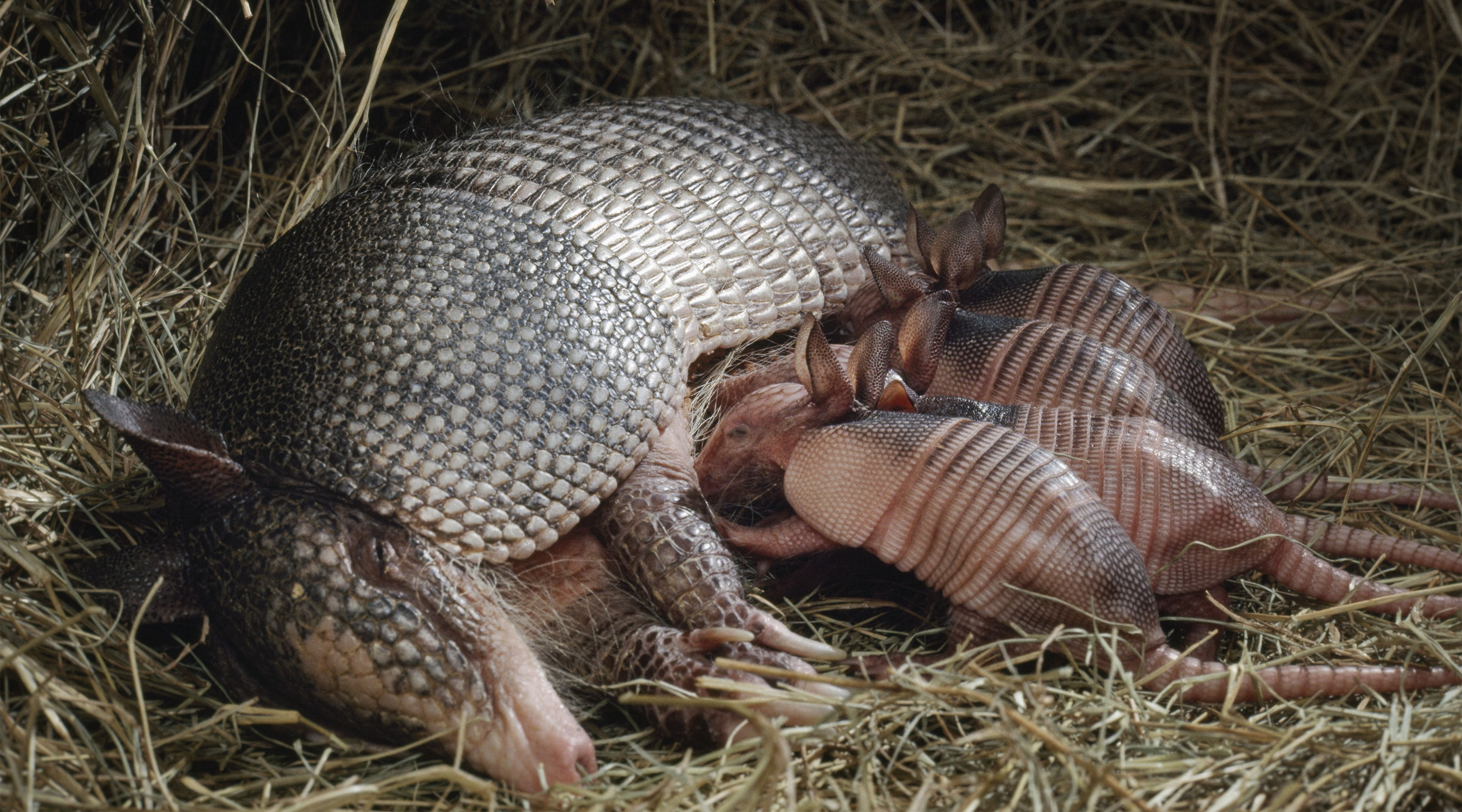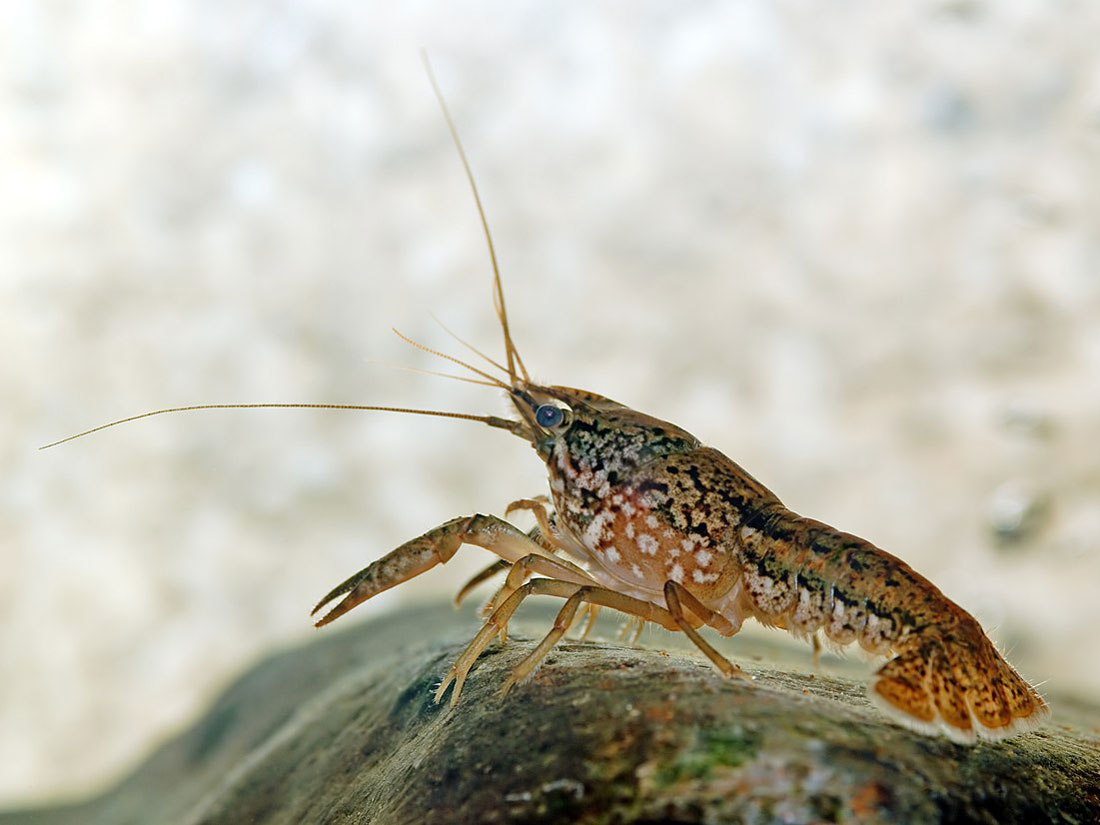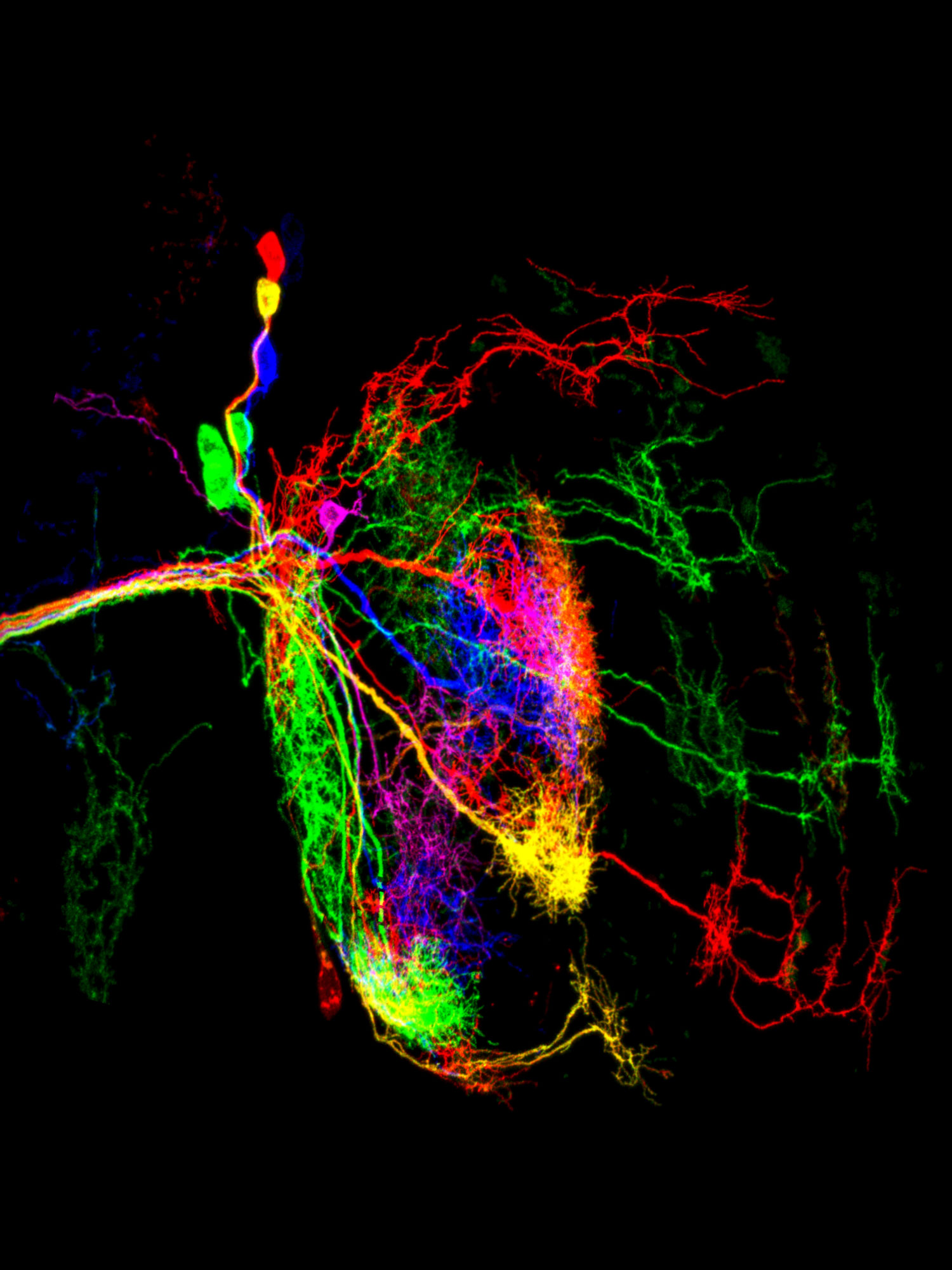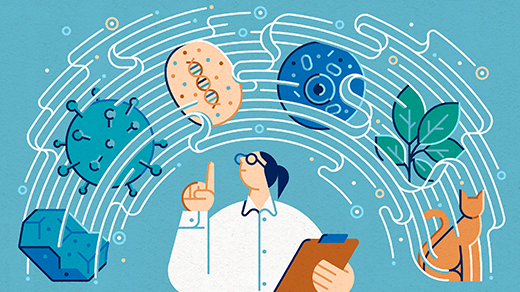Nature Versus Nurture? Add ‘Noise’ to the Debate.

Nine-banded armadillos always have litters of identical quadruplets. Researchers are now taking advantage of that system to study nongenetic sources of variation among individuals.
Introduction
In the 1990s, an army of clones invaded Germany. Within a decade, they had spread to Italy, Croatia, Slovakia, Hungary, Sweden, France, Japan and Madagascar — wreaking havoc in rivers and lakes, rice paddies and swamps; in waters warm and cold, acidic and basic. The culprits: six-inch-long, lobster-like creatures called marbled crayfish.
Scientists suspect that sometime around 1995, a genetic mutation allowed a pet crayfish to reproduce asexually, giving rise to a new, all-female species that could make clones of itself from its unfertilized eggs. Deliberately or accidentally, some of these mutants were released from aquariums into the wild, where they rapidly multiplied into the millions, threatening native waterways species and ecosystems.
But their success is strange. “All marbled crayfish which exist today derive from a single animal,” said Günter Vogt, a biologist at Heidelberg University. “They are all genetically identical.” Ordinarily, the absence of genetic diversity makes a population exceedingly vulnerable to the vagaries of its environment. Yet the marbled crayfish have managed to thrive around the globe.
A closer look reveals that the crayfishes’ uniformity is only genome-deep. According to studies conducted by Vogt and others in the mid-2000s, these aquatic clones actually vary quite a bit in their color, size, behavior and longevity. Which means that something other than their genes is inspiring that diversity.
Common sense tells us that if it’s not nature, it’s nurture: environmental influences that interact with an animal’s genome to generate different outcomes for various traits. But that’s not the whole story. New research on crayfish and scores of other organisms is revealing an important role for a third, often-overlooked source of variation and diversity — a surprising foundation for what makes us unique that begins in the first days of an embryo’s development: random, intrinsic noise.

Every marbled crayfish in the world is a clone — yet despite sharing a genome, individuals vary in color, shape, size and behavior. Some of those differences seem to be due to random, noisy events during their development.
Nature Versus Nurture Versus Noise
Scientists typically consider the phenotype of a cell or organism — the traits it expresses in its form, physiology and behavior — to be the complex sum of genetic and environmental factors, or “nature” and “nurture.” A great deal of research is dedicated to identifying the contributions of the former: to pinning down, for instance, how given mutations might determine the shape of a limb or the onset of a disease. “That’s certainly a very powerful paradigm,” said Arjun Raj, a systems biologist at the University of Pennsylvania. “We’ve learned an enormous amount from that, [and] it’s really easy to tell a story about it.”
Everything not chalked up to genetic control tends to get attributed to diverse environmental factors, ranging from nutrition to stress to idiosyncratic social interactions. It’s a line of thought that “suggests that it must be something outside the organism,” said Kevin Mitchell, a geneticist and neuroscientist at Trinity College Dublin.
But proof abounds that this is not entirely true. Identical human twins who share both a genome and a home don’t look or act exactly the same. A mutation that causes a disorder in one might not in the other. Twins even have different fingerprints.
The same goes for populations of bacteria, clonal fish, and inbred flies and mice. Some pathogens or cancer cells develop drug resistance, while their genetically identical sister cells perish. Marbled crayfish siblings raised in a lab where their environment is kept constant don’t just end up having different colors or shapes or behaviors — their differences are also significant enough for them to establish an entire social hierarchy.
Even within an individual organism, asymmetries arise between the left and right sides of the face, the body and the brain. Research is making it ever clearer that these differences can’t all be written off as unexplained environmental effects.
Which leaves noise — the random tremors and fluctuations that characterize any biological process. “Noise is inevitable,” said Andreas Wagner, an evolutionary biologist at the University of Zurich, “an inevitable byproduct of life.”
What makes noise inescapable, Mitchell explained, is that any organism is far too complex for genes to delineate, exhaustively and single-handedly, exactly how to build it. The wiring of the brain alone has to arise with relatively little instruction.
“The genome is not a blueprint,” Mitchell said. “It doesn’t encode some specific outcome. It only encodes some biochemical rules, some cellular algorithms by which the developing embryo will self-organize.” Molecules bounce around and interact in a cell, binding and pulling apart and diffusing at random. The processes that make proteins and turn genes on and off are subject to this “molecular jitter in the system,” as Mitchell calls it — which leads to some degree of randomness in how many protein molecules are made, how they assemble and fold, and how they fulfill their function and help cells make decisions.
As a result, it’s perfectly natural that development, the complex process that turns a single cell into an entire organism, would be “a bit messy,” Mitchell said.
But developmental noise was often dismissed as no more than that: something that clouds how biological systems should ideally function. It wasn’t treated as a source of biological creativity in its own right, and it certainly didn’t seem like something that could underlie major differences in traits as important as behavior or personality.
Even when scientists did want to focus on the effects of that noise, they found themselves hitting a wall: By definition, noise is not systematic or predictable, and as a result, it’s almost prohibitively difficult to isolate and measure. “It’s the most difficult [factor] to actually control, to play with,” said Bassem Hassan, a neurobiologist at the Paris Brain Institute. “You can play with the genome, you can play with the environment, you can play with physiology, you can activate certain cells and not others. … It’s a lot harder to manipulate the variation” and prove it to be the cause of differences in a trait of interest.
Mitchell agreed. “By its very nature,” he said, “random stuff is just super hard to work on.”
But that’s starting to change. Tools for studying the behaviors of single cells, including their gene expression, protein production and developmental fate decisions, have become sophisticated enough to let scientists ask questions about more subtle causes of variation. And what they’ve found is that developmental noise plays a role that can no longer be overlooked. It’s not just an inescapable effect that living systems have to put up with, but something that those systems evolved to take advantage of, turning it into a necessary driver of an individual’s proper development and perhaps even of evolution more broadly.
A Rainbow of Randomness
A turning point came in 2002. It began with bacteria and a rainbow.
Michael Elowitz, a professor of biology and biological engineering at the California Institute of Technology, and his colleagues wanted to test variation in E. coli cells growing in the same environment. They inserted two copies of a gene into the bacteria: one that encoded a cyan fluorescent protein, and another that encoded a yellow one. Since they had engineered the genes to be regulated identically, they expected to see the cells produce both proteins in equal amounts. Instead, within each individual cell, the cyan and yellow genes were expressed unevenly — and those ratios differed greatly from cell to cell. Some cells glowed more yellow than cyan, others more cyan than yellow. Still others were more of a mix, and all of it occurred seemingly at random. This rainbow, Elowitz and his team realized, was a clear result of the noise inherent in the process of gene expression. They were finally seeing the effects of the “molecular jitter.”
Since then, scientists have studied the role that intrinsic noise plays in other cellular processes. It can be seen in how a population of identical cells gives rise to different specialized descendants; in how some, but not all, of a group of cells may respond to a given signal; in how a developing tissue gets patterned. Cells make use of noise to create necessary variability in their behavior and biological state.
But that’s at the level of the cell. It could be that those differences tend to balance out across many such cells. Teasing apart whether noise could actually affect higher-level organisms —propagating through development to influence how an adult animal would turn out — was therefore a different story.
For one, it would require very specific experimental systems consisting of many individuals with the same genomes, carefully raised in the same environmental conditions. To some extent, that’s been done. Researchers have found that inbred, genetically identical flies in the laboratory display unique preferences when responding to a navigational task. Clonal fish exhibit behaviors as diverse as those observed in genetically variable fish, while altering the fishes’ environment has a negligible effect.
But these results still don’t prove that noise during developmental events caused those specific differences. “The worry, when you say there’s some variability [in] anatomy or physiology,” Mitchell said, “is that people can always come back and say, ‘Well, that’s just some environmental factor that you didn’t know about.’”
But a new study, posted on the preprint site biorxiv.org in December, has taken this kind of work to the level of gene expression — and in a mammal, no less.
Behold the nine-banded armadillo.
The Quadruplets That Aren’t
Nine-banded armadillos have an unusual reproductive strategy. They always have litters of quadruplets, four genetically identical armadillo babies. Jesse Gillis, a computational biologist at Cold Spring Harbor Laboratory in New York, and his colleagues decided to take advantage of that birth pattern to determine when random developmental noise starts leading to differences in the adult animals’ physiology and behavior.
“It’s a fantastic system experimentally to work on,” said Mitchell, who was not involved in the work. “I mean, who doesn’t like armadillos?”
Gillis’ team soon found that variation in gene expression appears very, very early on.
They obtained blood samples from five armadillo litters, sequencing their RNA three different times during the year after the animals’ birth and analyzing that data for unique gene expression patterns. They began by looking at a classic random process in genetics: the inactivation of an X chromosome.
In armadillos, humans and most other mammals, the females have two X chromosomes in each of their cells. To keep the expression levels of X-linked genes consistent between males and females, at some point during development, one X chromosome is completely turned off. Whether a cell chooses to turn off the X chromosome inherited from the organism’s mother or the one from its father occurs entirely by chance — like flipping a coin, according to Gillis. Yet that coin flip sets in stone which parent’s X-linked genes will be expressed in all of that cell’s descendants.
Gillis’ analysis found that this arbitrary coin flip occurred when the armadillo embryos consisted of a mere 25 cells. And because the precise combination of 25 random maternal or paternal X selections was different in every embryo, it became a permanent “identifying signature” for each of the genetically identical members of the armadillo brood.
The group then turned their attention to the 31 other pairs of chromosomes in the armadillos. Neither chromosome in those pairs gets as completely silenced as the inactivated X, but differences arise in how active each one is and how much each contributes to overall gene expression. The researchers used a machine learning method to analyze when those unique ratios became fixed in cell lineages. They estimated that it happened when the embryos had just a couple hundred cells.
In an armadillo that will eventually have a trillion or so cells, “these events are happening so early,” said Kate Laskowski, a behavioral ecologist at the University of California, Davis who does related work in clonal fish but did not participate in the study. “They have the opportunity to have really strong downstream effects. One cell early in your development will be the progenitor of hundreds, thousands, millions of cells later in life.”
It’s like ripples expanding in water: Throw a rock into a lake, and its weight and shape, together with the force with which it is thrown, will cause it to generate a different ripple than another rock would. The predictable physics of how a ripple spreads lets the effects of those unique initial conditions propagate. Similarly, the random noise that establishes a slightly different pattern of gene expression in each armadillo embryo is amplified through its influence on other developmental processes and eventually yields differences in traits.
To determine what those downstream effects might be, the scientists examined differences in overall gene expression. They found that armadillo siblings varied in their expression of about 500 to 700 of their 20,000 genes (although the scientists also expect that their analysis missed some fluctuations, so this might be an underestimate). Moreover, it wasn’t always the same 700 genes or so that were affected in each litter, offering further evidence that randomness dictated the variation.
Those gene expression differences, in turn, seemed to correlate with differences in a variety of traits, especially those associated with immune and hormonal processes. Most obviously, in one litter, some of the genes were associated with muscle growth — and those siblings did indeed vary significantly in size. While further work is needed to cement these associations, Gillis and his colleagues estimated that approximately 10% of the total variation they observed among the armadillos could be attributed to developmental noise.
“The idea that your phenotype and how you behave might be a result of seemingly random events when you are a ball of a couple dozen to a couple hundred cells,” Laskowski said, “to me, that’s fascinating.”
Fluctuations Affecting Behavior
Those random events seem to play the biggest role when it comes to behavior. In humans, for instance, identical twins differ far more in psychological traits than they do physically. And since psychological differences are thought to reflect how the brain is put together, the brain is where scientists are starting to look.
During development, brains are particularly noisy: Connections between neurons are constantly growing and getting pruned, often randomly. Ion channels spontaneously open up, and synapses spontaneously release neurotransmitters, for no obvious reason.
Genes have been found that govern the developmental variation in anatomical and behavioral traits. By altering those genes, researchers have been able to test their hypotheses about the role of noise in dictating brain formation and behavior. The most tantalizing example of this came earlier this month, in a paper published by Hassan and his colleagues in Science.

Asymmetries unique to individuals appear in the brain circuitry of genetically identical fruit flies, where the dorsal cluster neurons get wired together in a variable, noisy way. Those differences in turn affect the individual flies’ behavior on a navigational task. Researchers wonder to what degree random noise during brain development might influence human behavior as well.
Courtesy of Maheva Andriatsilavo
In 2013, they found that randomness in the mechanisms that wire certain neurons together produced variation in circuit patterns in the brains of genetically identical flies. Those neural connections not only varied from fly to fly but were also asymmetrical between each fly’s left and right brain hemispheres. In their new paper, the scientists have causally linked that anatomical variation to specific differences in behavior: Flies with greater asymmetry in those random wiring patterns walked more directly toward a target, while flies with more symmetry tended to weave and meander. When the researchers manipulated a gene to make the neural-wiring process yield more symmetric connections in the resulting flies’ brains, they saw less efficiency in the flies’ approaches to targets; an experiment that increased asymmetry similarly led to straighter walking paths.
All in all, they estimated that 35% to 40% of the variation in the flies’ walking behavior could be explained by random differences in the wiring patterns of the studied neurons. Which makes one wonder about the extent to which noisy brain development might impact unique behavioral or psychological traits in humans. “How much of who I am as a person is due to stochastic developmental events in my brain?” Hassan said.
According to Mitchell, depending on the trait, it could be as high as 50%.
Evolved to Be Noisy
The next step for these researchers is to test how this noise-induced variation might affect an animal’s fitness. It’s known that random noise is critical to the survival of bacteria and other single-celled asexual organisms. For them, random fluctuations allow for an evolutionary strategy known as bet hedging: The temporary, random introduction of variants into a population improves the species’ chances of survival should environmental conditions change. For instance, among infectious bacteria, the presence of a few “persister” cells that randomly shift into metabolic dormancy can help the population survive doses of antibiotics that wipe out the rest.
Noise also seems to spur the evolution of new traits. Unpublished work from Wagner’s lab and other groups has shown that introducing more noise to gene expression in E. coli and yeast allows them to evolve novel features more quickly.
The evidence for this kind of adaptive role for noise in the development of more complex organisms is less clear-cut. But, Hassan said, it’s reasonable to assume that studies will eventually connect the dots.
“There’s absolutely no doubt that it is a general biological principle,” Vogt said, one that converts the traditional genotype-to-phenotype map into a more open-ended relationship in which one genome encodes many possibilities.
The fact that randomness in development may be just as important as genetic and environmental variation could also change how we understand phenotype more broadly. “We always look for patterns and explanations for everything,” Laskowski said. “And so when we think about our behaviors and our personalities, we obviously want to think, ‘Oh, this is from how you were raised as a child,’ or ‘it was what happened to your mom,’ or some big explanation. But it turns out that it might not be such a big explanation. It might just be random chance.”
Mitchell agreed. “Many of our traits may be more innate than we think,” he said. (That is also the subject of a book Mitchell published in 2018, Innate: How the Wiring of Our Brains Shapes Who We Are.)
This idea carries other implications, particularly for those trying to use genetics to predict traits ranging from height and body mass index to intelligence and disease risk. “Ultimately, you’re going to be really, really limited in how accurately you can ever predict anything about an individual, if this kind of random variation is important for many aspects of traits that we care about,” Mitchell said.
Regardless, the broadening of the nature-nurture dichotomy to include this third major variable opens up many intriguing possibilities. “That’s my starting point now,” Mitchell said: It’s time to see what that expanded equation will reveal next about who we are and how we came to be.
This article was reprinted in Spanish at Investigacionyciencia.es.



